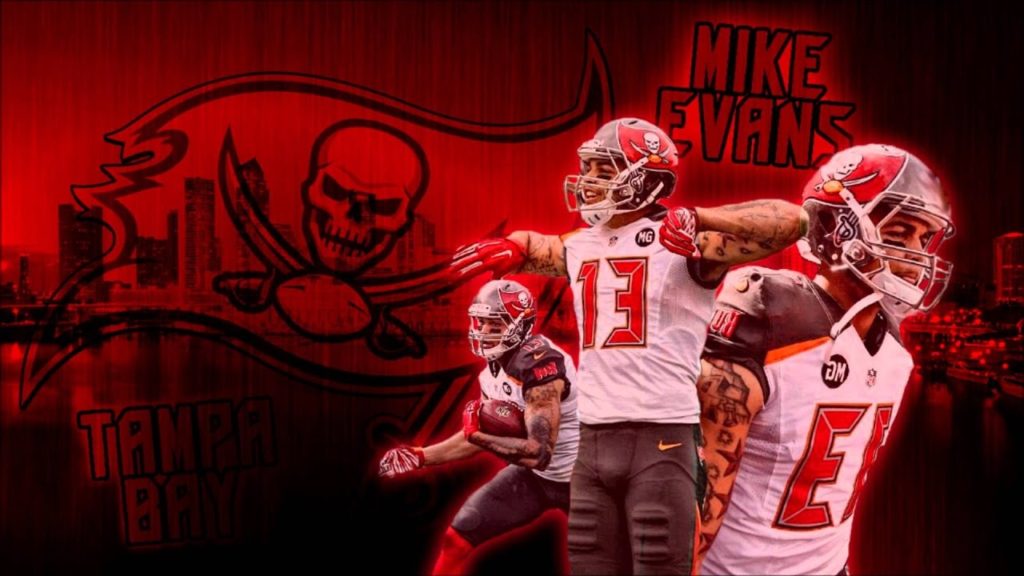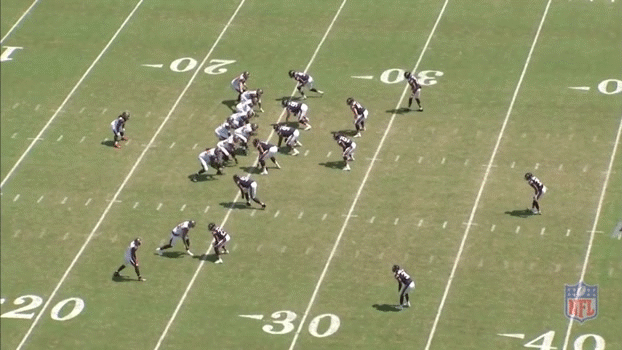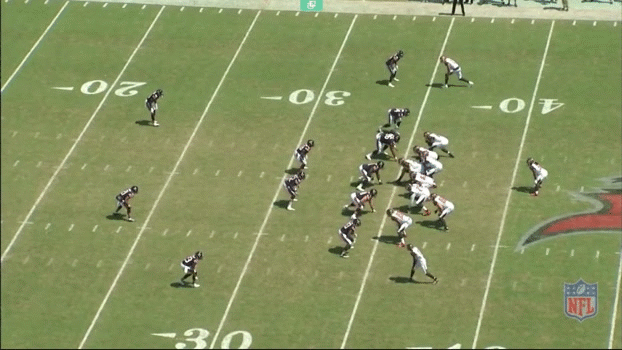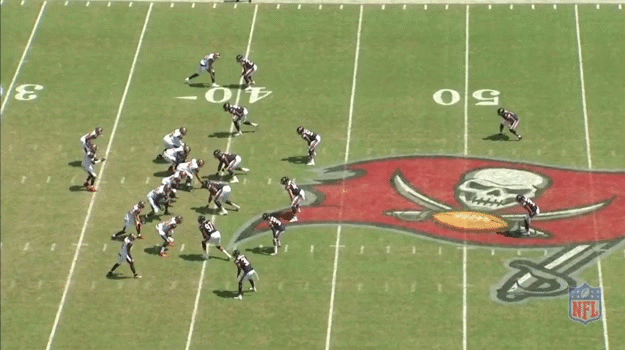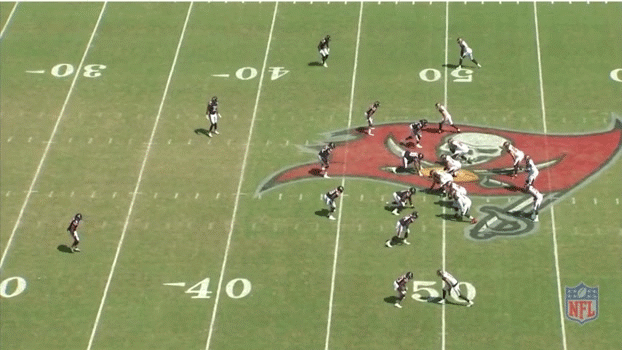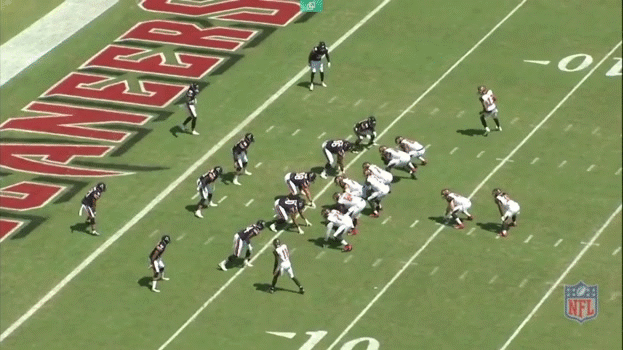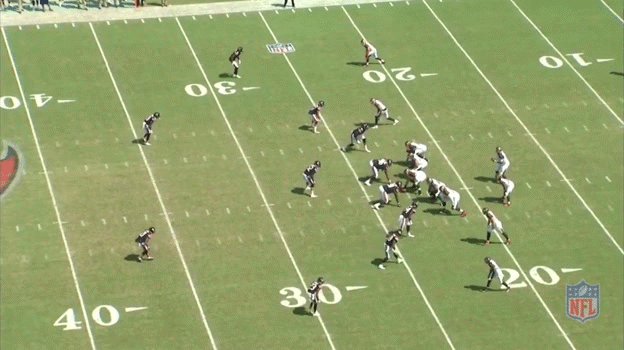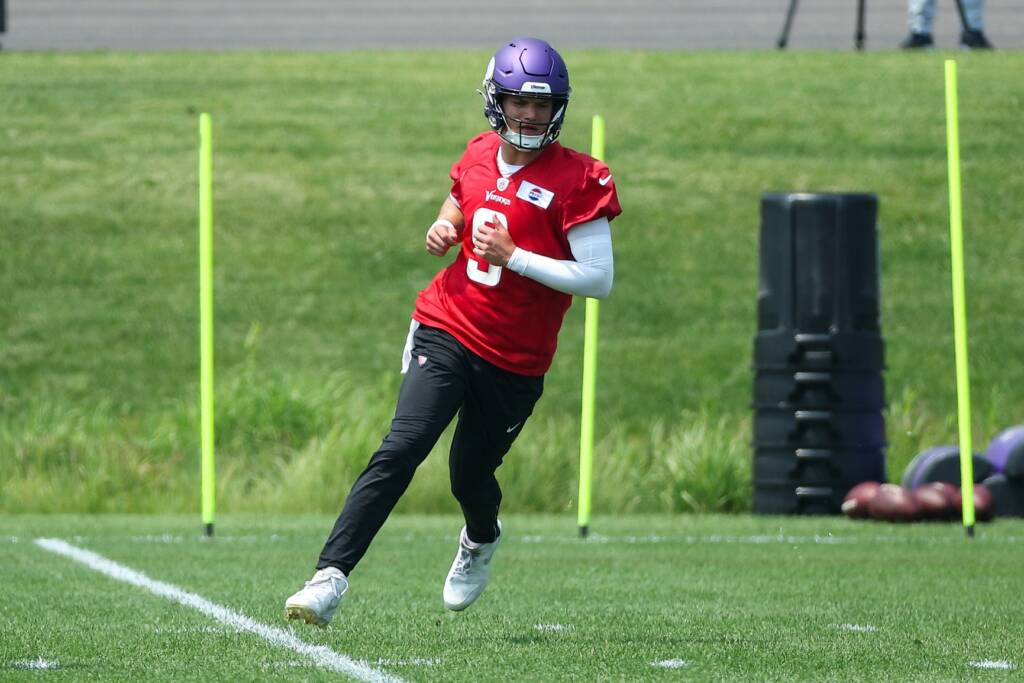Mike Evans is a good receiver. You don’t need much evidence of that, but it’s fun to display it, regardless. We’ll take a look at how Evans wins and how the Vikings might be able to contain him.
Advanced Statistics
Yards per route run is one of my favorite measures, and in my opinion, it more accurately reflects year-to-year skill than any other receiver metric; yards per route run is a more reliable measure than yards per target and measures contribution to the offense better than targets per route run.
I’ve corrected the metric to account for team passer quality so that receivers who have good passing offenses around them receive a small penalty and those in poor passing offenses get a bonus. After all, how good a quarterback a receiver has will do a better job getting them yards.
Evans ranks seventh. Entering his fourth year in the NFL, he’s nearing his peak abilities as a receiver and could present a greater problem for the Vikings this year than he has for opponents over the past two years.
| Rank | Player | Routes | QB-Independent Yards | QB-Independent YPRR |
| 1 | Julio Jones | 1067 | 3052.9 | 2.86 |
| 2 | Sammy Watkins | 610 | 1484.4 | 2.43 |
| 3 | Antonio Brown | 1193 | 2890.7 | 2.42 |
| 4 | A.J. Green | 877 | 2109.9 | 2.41 |
| 5 | Odell Beckham Jr. | 1193 | 2782.0 | 2.33 |
| 6 | Jarvis Landry | 1012 | 2302.7 | 2.28 |
| 7 | Mike Evans | 1090 | 2456.7 | 2.25 |
| 8 | Steve L. Smith | 694 | 1550.3 | 2.23 |
| 9 | Kenny Britt | 874 | 1913.5 | 2.19 |
| 10 | Alshon Jeffery | 726 | 1574.1 | 2.17 |
| 11 | T.Y. Hilton | 1240 | 2686.1 | 2.17 |
| 12 | Demaryius Thomas | 1149 | 2473.2 | 2.15 |
| 13 | DeAndre Hopkins | 1282 | 2739.4 | 2.14 |
| 14 | Rishard Matthews | 765 | 1618.3 | 2.12 |
| 15 | Emmanuel Sanders | 1067 | 2246.8 | 2.11 |
| 16 | Adam Thielen | 564 | 1152.6 | 2.04 |
| 17 | Terrelle Pryor | 564 | 1151.5 | 2.04 |
| 18 | Stefon Diggs | 867 | 1714.6 | 1.98 |
| 19 | Ted Ginn | 755 | 1477.2 | 1.96 |
| 20 | Brandon Marshall | 1193 | 2331.6 | 1.95 |
Incidentally, it’s nice to see Stefon Diggs and Adam Thielen ranking so high over the past two years.
So, we know that in a generalized sense, that Evans is good. What kind of good, though? Some receivers are better at keeping the offense on schedule, while others are deep shot specialists. Some can be high-variance with valuable plays paired with high drop rates, and others are meant to be outlet options that excel when the quarterback is late in the progression and the defense’s seams start to crack.
Mike Evans has been targeted more often, for deeper, than anyone else in the NFL.
Despite playing in a relatively volatile offense, Evans is a consistent receiver. He has a below-average drop rate (the average is 8.0 percent and his is 6.8 percent) despite some pretty tough assignments and occasionally spotty ball placement from his quarterback and he ranks second among all receivers in first downs per route run (ninth per target and first per reception).
He produced more total first downs than any other receiver in the NFL last year with 16 more — an increase of 24 percent — than the next guy
Evans has been the “go-to” receiver over the past two years. He’s been in an interesting spot, where he’s earned the third-most targets per route (ahead of Antonio Brown but behind Julio Jones and… Tavon Austin) while also generating the fifth-highest depth of target (Firs through fourth, respectively, are Sammy Watkins, now-teammate DeSean Jackson, Kenny Stills and Michael Floyd) ahead of deep threats like Will Fuller, Terrelle Pryor and Ted Ginn.
That means Evans has been targeted more often, for deeper, than anyone else in the NFL.
So why isn’t Evans, who doesn’t drop the ball much, gets targeted on deeper routes than most other receivers and earns more targets than most other receivers, the most productive receiver in the NFL?
Catch rate.
It’s not a statistic that speaks much to the receiver’s capability so much as the interrelated effects of quarterback play, offensive design and the difficulty inherent in consistently placing and winning deep shots accurately.
Evans has a hard job in the Buccaneers offense, and he does it really, really well.
The fact that not a lot of targets turn into catches for Evans (he ranked 59th of 61 qualifying receivers in the last two years) doesn’t take away his potential threat; he runs difficult routes and they put him in tough situations. Winston threw eight interceptions when targeting Evans last year, but it was worth it.
After accounting for touchdowns, first downs and interceptions, Evans ranks eighth in adjusted yards among receivers with at least 100 passing plays last year, and fifth among receivers with at least 400. Here’s the top 20 in yards per route, adjusted for first downs, touchdowns and interceptions (minimum 100 routes):
| Rank | NAME | Adjusted Yards per Route |
| 1 | Tyreek Hill | 4.67 |
| 2 | A.J. Green | 4.11 |
| 3 | Julio Jones | 4.11 |
| 4 | Taylor Gabriel | 3.92 |
| 5 | Cole Beasley | 3.35 |
| 6 | Odell Beckham Jr. | 3.34 |
| 7 | Antonio Brown | 3.28 |
| 8 | Mike Evans | 3.16 |
| 9 | Jarvis Landry | 3.13 |
| 10 | T.Y. Hilton | 3.03 |
| 11 | Julian Edelman | 3.00 |
| 12 | Michael A. Thomas | 2.88 |
| 13 | Dez Bryant | 2.84 |
| 14 | Jordy Nelson | 2.84 |
| 15 | Kelvin Benjamin | 2.84 |
| 16 | Rishard Matthews | 2.80 |
| 17 | Stefon Diggs | 2.80 |
| 18 | Brandin Cooks | 2.79 |
| 19 | Michael Crabtree | 2.78 |
| 20 | Cameron Meredith | 2.78 |
Evans can make inaccurate passes look good, bad decisions look smart and tough throws look easy.
Film
Evans is a big receiver, that’s undeniable. He knows how to use his size and leaping ability to create exclusive real estate for the ball, and Jameis Winston loves to throw the ball where only Evans can catch it. Often this means an uncatchable ball (again, Evans has one of the lowest catch rates in the league), but it’s been a huge weapon for the offense.
While Evans isn’t the fastest receiver (he ran a 4.52-second 40-yard dash and looks slower, though that could be because big players tend to look slower) he still finds a way to get open deep. A lot of that has to do with his technical skills; he has a variety of releases he uses at the line of scrimmage to separate quickly and he can stack defensive backs behind him with his big frame.
He also has uncommon quickness for a player of his size. While he looks lumbering while flying downfield, his ability to change directions or come to a stop quickly after running at full speed is a marvel. Below, he demonstrates the uncommon quickness he possesses in order to break free on an in-breaking route from the slot at the bottom of the screen.
In the following GIF, he does the same thing while threatening the cover-two safety with his deep potential and forcing the safety to backpedal. After that, he breaks inside with suddenness and is left with acres of space. This time, he’s at the top of the screen.
We even have a comparison. Both Evans (at the top) and Adam Humphries (at the bottom) run routes that require a hard stop. Though they stem at different times, one can see that Evans has more stop-start capability than the 5-foot-10 slot option with a 6.96-second three-cone.
Those clips also demonstrate what Evans can do to generate separation from the snap against press coverage. He has a variety of moves against press. The first clip above shows him one-arming a defensive back for space, and it turns into a swim moments later. The second clip above shows him stutter-stepping to create space and then accelerating through the open gap as soon as the corner takes one step.
He can also use hand fighting techniques to create that space. In addition to the footwork he demonstrated above, he can swat, like he does below (he’s at the top of the screen)
Once again, below (at the bottom of the screen), Evans uses footwork to create space.
Even when he loses, he wins. At the bottom of the screen below, Kyle Fuller gets a good one-arm jam in there before Evans can initiate contact and creates push. But Evans powers through and breaks free.
Evans has also demonstrated a swim move and other types of releases that make him a threat to catch a slant on any play, as well as generate the initial separation that has become so critical in the NFL.
Sometimes, he doesn’t use quickness, route-running or technique to get open, but power and the knowledge that he has the right of way. Check out his route in the red zone at the top of the screen:
So, how to stop him? Some of it will be unavoidable, even for a corner as talented as Xavier Rhodes. But Rhodes’ talent should be worth trusting.
In one-on-one situations, Rhodes has been phenomenal. Last year, he led the league in passer rating allowed in coverage, and held players like Kelvin Benjamin, Larry Fitzgerald, Alshon Jeffery and Odell Beckham Jr. below their three-year per-game averages.
In the past three years, the top-25 receivers in total receiving yardage have played the Vikings 43 times. They generally average 73 yards per game, but against the Vikings could only manage 58. In only 15 instances have top receivers had more yards against the Vikings than they did on average, and most of those instances were in 2014. In 2016, top receivers fell below their yards-per-game average 70 percent of the time.
Rhodes has more press coverage capability than a corner like Fuller, and should be able to take advantage of wins at the line of scrimmage with more capability. He can keep up with sudden receivers on comeback routes and play through their routes for them.
Still, the Vikings wouldn’t be wrong to roll with a gameplan heavy in Cover 2 principles, with Andrew Sendejo and Harrison Smith on top of Rhodes and Trae Waynes. They cannot simply stay in Cover 1 with one safety on top of Evans because that would leave Waynes to deal with DeSean Jackson alone. Even with Waynes’ prodigious speed, Jackson’s technical skill, experience and quickness would cause problems without a good stopgap.
The Bears elected to do the same thing and despite the lopsided score (29-7) actually did hold the Bucs back. Tampa Bay only scored two offensive touchdowns and did so with the benefit of some outrageously short fields after multiple Bears turnovers early in the game.
Winston was held to 6.69 adjusted net yards per attempt; only getting 204 passing yards on 30 attempts with a touchdown (to Evans). With one fewer player in the box, one might think that the Bucs running game could get going, but running backs only averaged 3.93 yards per carry. That wasn’t a garbage time effect, either; in the first half of the game, Tampa Bay running backs only averaged 2.92 yards per carry. Their longest run was nine yards.
Tampa Bay’s touchdown drives were 13 yards and 35 yards and their average drive in the game was only 34 yards. They did have two fairly long drives, so the Bears certainly didn’t have a perfect defensive strategy, but it’s clear that staying in Cover 2 on a number of snaps wasn’t significantly detrimental despite their lack of defensive talent.
That won’t be enough, of course. The Vikings will want to bait Winston into throwing more turnovers and generate their first of the season. That will mean rotating the looks underneath, and there’s a lot of potential there. The Buccaneers don’t seem to engineer too many “hot” routes—routes that change in response to a blitz—or many options at all in response to the coverage.
Below, a cornerback blitz results in a protection change (for the running back), but doesn’t result in any route changes that take advantage of the short space left behind by the blitzing DB.
Christian Jones was late to react to Winston’s eyes and the long route, but it’s clear from that play and others for the past few years that there are few route adjustments against coverage, which really gives Minnesota an opportunity.
Creating confusing looks might be the Vikings’ best bet in containing such a good player. Zone blitzes with dropping linemen, trap or disguised coverages and so on.
Against blitzes and on third down, Winston looks to Evans’ direction more often than any other receiver, and the Vikings can use that to create turnovers or at least force incompletions.
Evans’ very nature as a physically dominant, unnaturally quick and savvy receiver will make it difficult no matter what, but the Vikings have the talent and the tools to get the job done.
